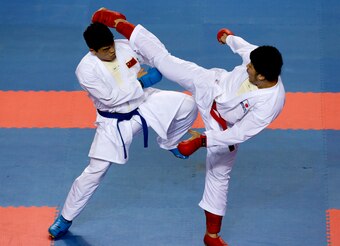Hey guys,
People seem to like it when I write about traditional martial arts, and Machida always gives me the chance to do that! Pulled out the scanner and lots of old books for this one :)
Hope you don't mind clicking the link and as always all feedback is welcomed!
Cheers,
Jack

I've written plenty about Lyoto Machida's karate over the past two years, but today I thought we would try something different.
I usually speak at length about Machida's striking style, which is very much influenced by tournament karate, and indeed Japanese karate. Shotokan is, after all, considered a Japanese style of karate rather than an Okinawan one.

In karate tournaments, oven gloves must be worn on all striking surfaces.
The differences are many but among the most obvious are that Japanese styles (Wado-Ryu, Shotokan, Kyokushin and it's variants) tend to focus more on repping out basic techniques and practising kata (forms) into infinity. They use longer stances and tend to be more about pure striking than self defence. This is for the simple reason that when Gichin Funakoshi (the founder of Shotokan) went to mainland Japan from Okinawa, he found himself teaching high ranking judoka at the request of Jigoro Kano (the founder of Judo).
Not wanting to teach simple throws and grapples to guys who had spent years turning that into an art form, and having to teach in the regimented environment that the Japanese love, Funakoshi's karate became less Okinawan and more like it is today. Looking at Shotokan next to more traditional Okinawan styles such as Goju-ryu and Uechi-Ryu, they are starkly contrasted.
The truth of it is that real karate, as in the original applications (orbunkai) of the forms, is not going to win you many tournaments. Karate developed from the citizens of a disarmed Japanese colony's need to defend themselves from attackers in self defence scenarios, not the need to fight off samurai or other trained martial artists.
Old school karate, the kind found in decent applications of kata, is pretty much all about grabbing at the crotch, headbutting, and breaking free of grabs or defending basic, street attacker style swings.
That said, Machida himself has shown some slick little techniques which hark right back to the old days of rough and tumble karate. I am a firm believer that many (though not all) old, traditional techniques which look ridiculous can be reconfigured and given an appropriate set up to make them effective. Hell, the Showtime kick should have made us all a little more open minded, that was straight out of a kung fu movie. Today we'll look at one ugly, simple, wooden, old school karate technique which Machida has demonstrated successfully in the octagon.
The Wedge Throw
This technique is sometimes referred to as sukui-nage, which means scooping throw, but there are already two throws in judo which are known as sukui-nage... so let's not confuse things further. For now I'm just going to call it the wedge throw.
Before we go on, I know some of you are curious so here are the two sukui nage from judo.

The first is the traditional version.

The second is the one which proved more practical.
Now onto the throw that I'm talking about. It's different from those two, but more akin to the first.
The idea of stepping behind the opponent's lead leg so that the inner thigh is high on his out thigh, then dumping him over that leg, is an old, old, incredibly old school move. Pretty much any time you see a downward block (gedan-barai / gedan uke) in a karate kata, it can be applied as scooping the opponent over that lead leg. Indeed this is much of what Gichin Funakoshi taught himself.
Here it is demonstrated in the eccentric Shigeru Egami's book, The Heart of Karate Do as an application of a basic downward block. Egami was one of Funakoshi's original students but became gradually more eccentric after Funakoshi's passing.

The Heart of Karate-do, Shigeru Egami
Now of course, in a fist fight in the pub or down a dark alley, the opportunities to dump someone over your lead leg are going to be more forthcoming than against a professional fighter in his well practised stance. Heck, plenty of altercations at the bar see one or both men trip over themselves while throwing punches anyway.
So here is how the Japan Karate Association thought this technique could be best applied against an opponent in a stance, during a kumite match.
http://www.youtube.com/watch?v=v38XQJgK7W0
Yep, that is the legendary Keinosuke Enoeda, and no there isn't much tact to it. You dive in deep, and they fall over or they don't. Most of the time they didn't. Watching back any old kumite match it's the usual skittish trading of reverse punches and running. Not much of this being applied at all.

Here's Seiji Nishimura, a living karate manual and coach of the Japanese team, demonstrating a much more sensible application of the same technique, in counter to an opponent's attack. And not some BS stepping punch either, the kind of jab you might see in competition or in any combat sport. Even then, however, you would be hard pushed to find examples of it in high level karate competition.
Even Mas Oyama, known for founding a style of karate which was all about striking and not so much about old school self defence techniques, became enamoured with techniques like this in his later life. In Advanced Karate (an incredibly hard book to find in English and one which I am very luck to own), Oyama demonstrates dozens of variations of this simple step behind and bail them over type throw.

Here's one over the arm, as in traditional applications.
Continues at: http://bleacherreport.com/articles/1960174-lyoto-machida-old-school-karate

